
-
 Israel says killed 15 Hezbollah militants in Lebanon strike
Israel says killed 15 Hezbollah militants in Lebanon strike
-
Phasing out teen smoking could save 1.2 mn lives: study

-
 'Kill him first': Israel eyes top level targets
'Kill him first': Israel eyes top level targets
-
Championship leader Martin warns of 'unpredictable' Japan MotoGP

-
 France must fully probe Azerbaijani dissident's killing: Amnesty
France must fully probe Azerbaijani dissident's killing: Amnesty
-
'Welcome relief': Asia producers hail EU deforestation law delay
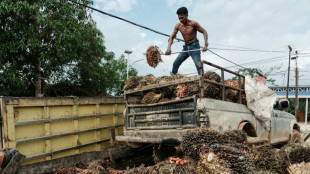
-
 Japan PM slated to announce plans for 'happiness index'
Japan PM slated to announce plans for 'happiness index'
-
Turkish inflation falls less than expected in September at 49.4%

-
 Easing inflation lifts profit at UK supermarket Tesco
Easing inflation lifts profit at UK supermarket Tesco
-
Skiing calls on UN climate science to combat melting future
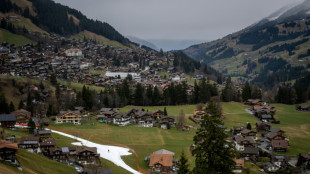
-
 China wine industry looks to breed climate resilience
China wine industry looks to breed climate resilience
-
Gaza war fuels Arab support for Palestinians, to little effect

-
 Dutch airline KLM unveils 'firm' cost-cutting measures
Dutch airline KLM unveils 'firm' cost-cutting measures
-
Sri Lanka spinner Jayawickrama banned from cricket for corruption

-
 EU top team knuckle down for 'scary' confirmation hearings
EU top team knuckle down for 'scary' confirmation hearings
-
Gruelling schedule highlighted as Alcaraz runs from stadium to airport

-
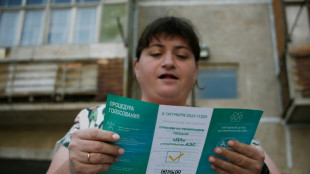 'People will come back': Kazakhstan debates nuclear future
'People will come back': Kazakhstan debates nuclear future
-
'They even murder children': Burkinabes caught in conflict crossfire

-
 Carpe diem: the Costa Rican women turning fish into fashion
Carpe diem: the Costa Rican women turning fish into fashion
-
Senegal looks to aquaculture as fish stocks dwindle

-
 Deadly strike on central Beirut after Israel, Iran trade threats
Deadly strike on central Beirut after Israel, Iran trade threats
-
Will AI one day win a Nobel Prize?

-
 Conte plays down Napoli's title chances
Conte plays down Napoli's title chances
-
Tolstoy's descendants in family saga over Russian peace prize

-
 Climate change, economics muddy West's drive to curb Chinese EVs
Climate change, economics muddy West's drive to curb Chinese EVs
-
Tigers, Royals, Padres advance in MLB playoffs, Brewers stay alive

-
 Singapore ex-minister sentenced to 12 months in prison in rare graft trial
Singapore ex-minister sentenced to 12 months in prison in rare graft trial
-
Baseball 'superhuman' Ohtani finds new ways to amaze among greats

-
 TotalEnergies plans to grow oil and gas production until 2030
TotalEnergies plans to grow oil and gas production until 2030
-
2024 Nobels offer glimmer of hope as global crises mount

-
 Tokyo rallies on weak yen, Hong Kong reverses after surge
Tokyo rallies on weak yen, Hong Kong reverses after surge
-
Australia's world No.7 Green wants women to play Presidents Cup

-
 Mexico leader worried about drinking water after Hurricane John
Mexico leader worried about drinking water after Hurricane John
-
Tunisia readies for vote as incumbent Saied eyes victory

-
 Messi scores two as Miami clinch MLS Supporters' Shield
Messi scores two as Miami clinch MLS Supporters' Shield
-
US election like no other enters nail-biting final month

-
 Morocco mobile desalination units quench remote areas' thirst
Morocco mobile desalination units quench remote areas' thirst
-
US election: five key moments in an extraordinary campaign

-
 High childcare costs in US weigh on women's employment
High childcare costs in US weigh on women's employment
-
US voters seek help with crushing childcare costs

-
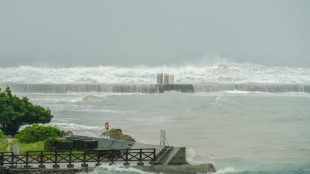 Taiwan shuts down for second day as Typhoon Krathon to land
Taiwan shuts down for second day as Typhoon Krathon to land
-
Chappell Roan drama sees US singer's fandom get political -- and pushy

-
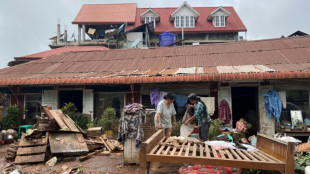 Supercharged storms: how climate change amplifies cyclones
Supercharged storms: how climate change amplifies cyclones
-
Huge protests in Argentina over public university cuts

-
 Deadly Israeli strike on central Beirut after soldiers killed
Deadly Israeli strike on central Beirut after soldiers killed
-
Trump 'resorted to crimes' to overturn 2020 election: special counsel

-
 Tigers and Royals complete sweeps to advance in MLB playoffs
Tigers and Royals complete sweeps to advance in MLB playoffs
-
Australia's most capped footballer Polkinghorne to retire

-
 Emery masterminds 'statement' Champions League win for Aston Villa
Emery masterminds 'statement' Champions League win for Aston Villa
-
Ancelotti holds hands up as Real Madrid's long unbeaten run ends

| BCC | -1.33% | 139.53 | $ | |
| SCS | -2.56% | 12.87 | $ | |
| JRI | -1.12% | 13.38 | $ | |
| NGG | -1.85% | 68.78 | $ | |
| RIO | -0.48% | 70.82 | $ | |
| GSK | -2.15% | 39.45 | $ | |
| BCE | -1.13% | 34.44 | $ | |
| CMSC | 0.04% | 24.78 | $ | |
| AZN | 1.14% | 79.58 | $ | |
| CMSD | -0.04% | 24.93 | $ | |
| RBGPF | 100% | 59.99 | $ | |
| RYCEF | 0.14% | 6.91 | $ | |
| BTI | -1.33% | 35.97 | $ | |
| BP | 0.86% | 32.37 | $ | |
| VOD | -2.16% | 9.74 | $ | |
| RELX | -0.11% | 47.29 | $ |

China wine industry looks to breed climate resilience
At a laboratory in Beijing, purple and green hybrid-species grapes are laid out on a board for testing, part of the strategy China's nascent wine industry is using to try to combat climate challenges.
Scientists are using genetics and artificial intelligence to address imperfect weather conditions, as well as anticipate future problems that might be wrought by rising global temperatures.
"In China, since we have a quite young industry, we don't have many clear observations about the effect of climate change," Dai Zhanwu, a professor at the Chinese Academy of Sciences (CAS), told AFP.
"But globally... there are many clearly observed impacts."
The world's wine production dropped 10 percent last year mostly because of "extreme environmental conditions" such as droughts and fires, according to a leading industry body.
Scientists say climate change driven by greenhouse gas emissions is making extreme weather more frequent and intense.
Global warming is also affecting grape quality, a recent review in science journal Nature said, meaning "the suitability of current winegrowing areas is changing, and there will be winners and losers".
Many Chinese wineries are determined to overcome those challenges.
"(Producers) are consulting us to see what will happen in the next decades, what they should do to be prepared," said Dai, whose work also involves collaboration with European institutions.
- Climate instability -
Solutions are sought both in the sterile calm of CAS laboratories and in the dusty fields of wine-producing areas like northern Ningxia.
There, temperatures in winter drop so low that vines have to be buried.
Producers told AFP they were already seeing the effects of a hotter world.
"They really fear it," said Ningxia-based researcher Liang Yuwen.
"From the point of view of a cultivator, the most feared thing is instability of climate, like sudden cooling, like hail, like extremely cold weather."
Liang and others told AFP harvests were starting earlier because of climate conditions.
Award-winning winemaker Zhang Jing said she has noticed the effect of warmer temperatures on her grapes.
"When the climate is suddenly hot, the grapes ripen too fast... The accumulation of sugar is too high, but the acidity is too low. This imbalance is a huge challenge," she said.
Zhang and others said they were experimenting with cultivation practices, and even considering starting vineyards in cooler locations, such as mountainous Yunnan and Tibet.
Dai's team in Beijing are using mathematical and climate modelling to try to predict where future growing regions might be.
"We want to know if we plant some vineyards in a given position, whether that position will keep the sustainability in the context of climate change, so what will happen in the next 10, 30 or 50 years," said Dai.
- Creating hybrids -
The most ambitious strategies involve developing new hybrid grape varieties that are more resistant to inclement weather.
In Beijing, Dai and his colleagues are delving into grape DNA, trying to understand the roles specific genes play in factors like colour, aroma and drought resistance.
Each year, the lab has the potential to produce around 20,000 new genotypes through crossbreeding, all of which must be evaluated.
Previously this was done manually, but now scientists use AI image recognition software to record aspects like colour, shape and size in seconds, cutting the time needed to identify candidates for further cultivation.
Promising strains are tested in the field.
At an experimental CAS vineyard in Ningxia, researcher Xie Jun showed AFP around rows of hybrid vines, their bunches of fruit protected by mesh bags to keep away pests.
"(The point is) to cross the good traits of the parent vines. So for instance, the father plant's cold resistance and drought resistance might be better, and then for the mother plant, the fruit quality might be better," he said.
As climate change impacts grape quality, "existing varieties will not be able to meet the standards of the raw materials needed for winemaking".
"Hybrids are what they need," he said.
- 'Chinese characteristics' -
There are already registered Chinese hybrids used in winemaking, the best known being Beihong and Beimei.
They were developed by crossing a cold-resistant native wild vine, Vitis amurensis, with better-tasting European species.
The resulting plants can resist temperatures lower than minus 20 degrees Celsius (minus 4 Fahrenheit), so do not need to be buried in winter.
That has saved Jiuxi, a hybrid-using winemaker Liang works with, a lot of money.
Sipping on its wine Dream Joy, a semi-sweet red, Liang said confidence in hybrid grapes' quality was growing.
"(Producers now) feel that this variety will certainly be able to make a wine with Chinese characteristics," he said.
While in the past hybrids were not thought to make particularly good drinking -- a "prejudice", said Dai -- they are now more widely used.
"With the challenge of climate change, I think during the last 10 years, even in Europe, they changed their mind," Dai said.
T.Batista--PC
